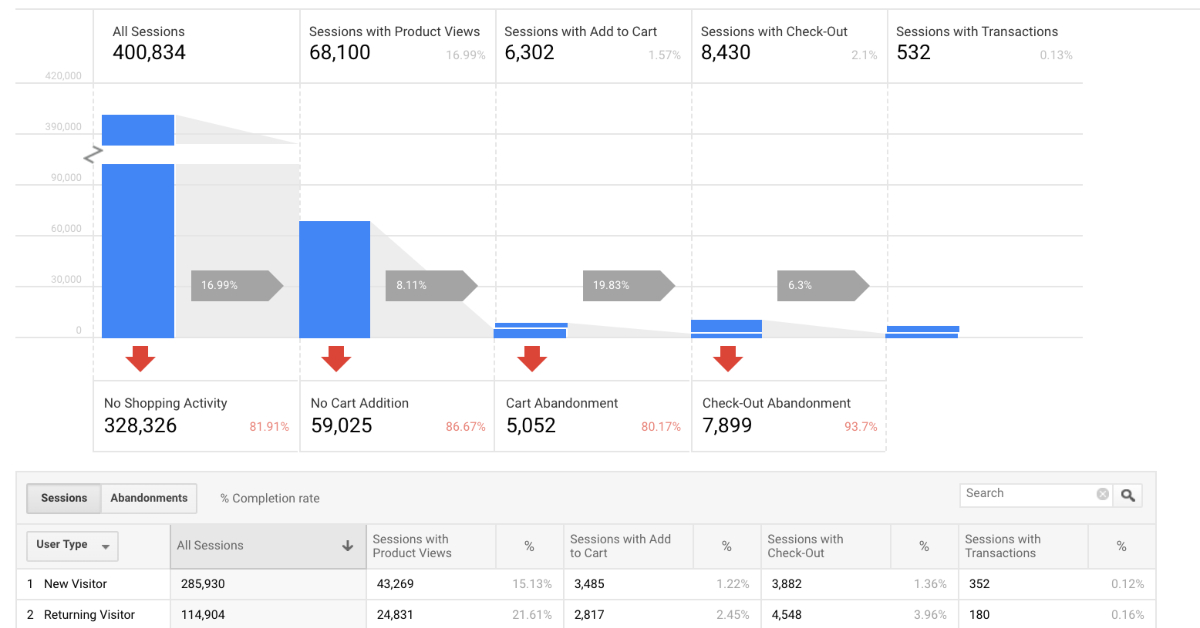E-commerce marketers often ask us if it makes sense to install enhanced e-commerce tracking in Google Analytics.
Deploying enhanced e-commerce gives you access to a dozen of additional primary dimensions, such as product lists, product names, SKU’s etc. You can intersect them with a number of secondary dimensions, such as country, city, marketing source and medium and others.
So, you get a lot of new data, that’s clear. But how much valuable knowledge will you really get?
To help you figure it out, we’ve assembled the list of 51 specific questions you can answer with Enhanced E-commerce.
We’ve grouped the insight questions into 4 sets, each one corresponding to one or more EE reports (available under Conversions).

So, what is it that you can learn with Enhanced E-commerce? Here’s the list.
Checkout and shopping behaviour (12)
What is the conversion rate of the entire checkout funnel (from shipping info through order review to transaction)?
How effective is the checkout funnel across new versus returning users and across various age groups?
At which step of the checkout funnel are users most likely to bounce?
How’s the checkout traffic purchase intent varying across traffic sources, campaigns, and keywords?
How much does the obligatory account signup as a checkout step decrease the conversion rate in the store?
Is credit card payment working correct?
Should you add more delivery options or reduce delivery times or costs?
Which devices have an unoptimised checkout process?
Which of the order form fields generate the largest amount of bounces and is it worth investing in e.g. address verification?
What is the impact of available payment options on the conversion rate and average order value?
What is the conversion rate at each step of the e-commerce user journey?
What are the check-out and cart abandonment rates across marketing sources and devices?
Product and sales performance (17)
What is the revenue, tax, shipping costs and refund amount of each transaction?
How many days elapse between the campaign referral and the conversion for each transaction?
Which brands generate most of the revenue?
Which brands are most likely to be refunded?
Which brands perform best with affiliate marketing?
Which product categories are most often refunded and what’s the breakdown of refunds by age?
Which product brands and categories tend to have the most convincing product descriptions, and which should be improved?
Which products tend to be chosen by the new versus returning users?
Which products are most likely to be chosen together?
How loyal are the customers of various brands?
What are the best products by engagement and sales across various age groups?
What is the total shipping cost for a given time period and across various delivery locations?
Which products generate the highest shipping costs?
What is the refund rate of each product?
Which marketing sources and delivery locations generate the most refunds?
Which products are rising stars, cash cows, and which are struggling to generate sales?
Which 20% of products generate 80% of sales?
Product pages and product lists (11)
Are products presented in the correct order in the product lists?
How engaging are the cross-sell and up-sell blocks in terms of clicks, add to carts, checkouts, transactions, and revenue?
Which marketing campaigns and locations generate the highest sales from the up-sell and cross-sell boxes?
Which products should be included in the up-sell and cross-sell boxes?
How relevant are recommendations shown in the “related products” boxes?
Which product categories drive most sales?
How to reshuffle products in the product lists to optimise sales and revenue?
Which keywords drive the highest quality traffic to product lists?
What ad content does the best job of introducing a given product list to the user?
Which product list position most users never scroll beyond?
Are product search results resonating with user expectations ?
Internal promotions, coupons and affiliates (11)
How many transactions resulted from the view-through or click-through of the internal promotions?
Which products should be featured in the main page promo slider?
What should be the optimal main page slider speed?
What’s the CTR impact of changing the position of the internal promotion banners?
Which internal promotion banners perform best?
How effective are limited time offers at driving transactions?
Which demographics has the highest responsiveness towards internal promotion banners?
How much sales is generated by individual affiliates?
Which products are most often bought with coupons?
What are the differences in the average order value between affiliates?
Which traffic sources work best with affiliates?
The verdict
Psst… Before you make a call whether it’s wise to upgrade your Analytics with Enhanced E-commerce module, make sure to check out our Enhanced E-commerce implementation offer!
Work and learn with us
If you like our thinking and would like to turn your manual marketing engine into a data-driven, semi-autonomous growth machine – get in touch with us and book your spot on the scoping call in the widget below or jump on the comprehensive, 90-minute, private workshop on building data-driven growth engines hosted by Datomni experts!



